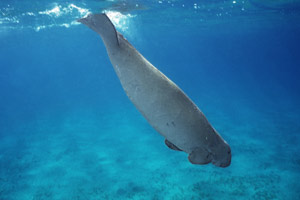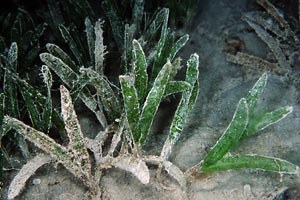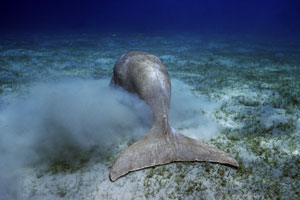|
|
| |
 
 |
A dugong dives
after breathing |
The dugong' behavior has been studied mainly in Australia, where the largest population can be
found. It lives in small groups, but herds of hundreds of individuals have been reported too. Unfortunately
this can't happen any more in many countries, where only few specimens survive along hundreds of kilometres of coast.
Feeding is the principal activity of dugongs and occurs preferably in shallow waters (1-6 meters).
Its daily need has been estimated in 30 Kg. Its diet is based on Phanerogams seagrasses of the families
Potamogetonaceae, Hydrocharitaceae and Cymodoceaceae. It normally feeds itself on the whole plant,
roots included, otherwise, if the plants cannot be uprooted, only on its leaves. Dugongs are very selective
in their diet, preferring high nutrients and highly digestible seagrasses, like Halodule rhizomes,
rich in nitrogen and poor in fibres, and Halophila, easy to digest. This means that the dugong gives priority
to quality and not to quantity.
| |
 
 |
| A Phanerogam Cymodocea serrulata |
When lacking in seagrass, the dugong can occasionally feed itself on algae, but this is not part of
its normal diet. In some cases, the examination of stomach and faecal samples have revealed the presence of small
invertebrates, the ingestion of which should be considered accidental. Some investigations (Anderson 1989 and Preen
1995) show that the dugong forages deliberately on macro-invertebrates only at the southern limits of its distribution
in both western and eastern Australia. But there is no evidence of this feeding habit in more tropical areas.
Because of this selectivity on diet, not all seagrass meadows are suitable as a dugong habitat. It seems also
that the grazing activity alters, on a local scale, the seagrass composition, increasing its components quality
if compared to seagrass meadows that rely only on natural turnover rates for recycling and redistribution of
nutrients.
I had the chance to witness a dugong's "dinner" for about one hour. I had the impression of it being very
methodical in its proceeding along the sandy bottom, rich of seagrass. It moved with its short flippers, making
clouds of sand while filtering the food. Once every 3 minutes or so, in which it covered at least 2 meters,
it had to surface in order to breath. It stopped for few seconds, taking at least 2 or 3 deep breaths, then dived
again and went on eating. It's not surprising that in such conditions it can ingest also some small crustaceans, that
is hiding in the sand.
The dugong doesn't have a preferred time for feeding itself: it doesn't rely on the position of the sun, but on tides,
choosing the right time to enter the sheltered bays where it also spends the night, protected from waves or other
dangers (such as big sharks).
| |
 
 |
| This photo shows the big tail, similar in shape and proportion to the
whale's tail. Looking at the displaced sand, we can also understand how the dugong moves while feeding itself, using
only its flippers and not its tail. |
|
In the mating period, that occurs throughout the year, male dugongs become aggressive and
compete violently for females, trying to embrace them and mate. Perhaps this could justify all
those scars on the back and sides of the female specimen I met.
A different behavior has been observed at South Cove in Shark Bay (Anderson 1997). The resident male dugongs
aggregate at a traditional site, used for this purpose and not suitable for everyday life, lacking many resources
females usually require. Here every male chooses his own area, that defends from other males' intrusions and displays
unique behavior, in order to attract females. Females visit this site only to mate, choosing a male in the group.
It's not known whether this behavior occurs in other places.
The dugong swims with slow movements of its tail. The average speed is 10 Km/h, which
can be doubled for short distances, in case of danger. The movements of 60 specimens have been tracked by VHF
or satellite transmitters in Indonesian and Australian waters. The longest movements are normally due to
climatic reasons, such as the need of warmer water in winter season.
At Moreton Bay (Queensland), many dugongs make daily round trips of 15-40 km, to go from the shallow
water where they feed themselves to the open ocean, where water temperature is 5°C warmer.
Daily movements depend also on tidal amplitude: a large tidal range normally means longer trips. Sometimes
dugongs have to wait a water level of at least 1 meter to get back into the bay or lagoon.
Very long movements have been tracked, some of hundreds of kilometers: a female crossed the gulf of
Carpentaria (600 km) in only 5 days.
In 2001, after many years of absence, dugongs have been spotted again in the atoll of Aldabra
(425 km from Madagascar). They have been seen in the large lagoon and near the 'Main Channel',
north-west of the island, not far from the local scientific station. This demonstrates also that
the dugong has the capacity to cross deep ocean trenches (more than 4.000 meters deep), making very long
migrations. This information indicates that the management of the protection of this species is an international
responsibility, not only limited to those countries where the dugong is living today.
NB: enlargements of all these photos are available in the Photo Gallery
[Home] | [Main
Index] | [Biology] | [Top]
|
|